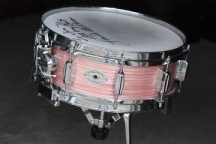
Case Studies
See the Virtual Incubator Start-Up Program In Action
How a Reluctant Entrepreneur With a Life-Long Passion Became a Joyful Business Owner

The Client: Jim Glay, Arlington Heights, Illinois
After two decades as a music industry executive, Jim Glay was laid off last year. “It was a real surprise,” says Glay, 60. “I thought I’d be the last one to go because of my tenure and performance”.
Despite calling all of his contacts, networking like crazy and applying for endless jobs online, Jim landed only six job interviews in a year’s time – many for work that paid less than $15 per hour.
While attending a job seeker’s workshop sponsored by a local church, Jim met Jeff Williams, the certified Virtual Incubator business start-up coach for the Chicago area. During a 30-minute conversation, it became very clear to Jeff that Jim’s long-standing history of gigs as a professional drummer and his extensive collection of vintage drums could easily be adapted into a profitable business. Jim saw the potential too and quickly signed up as a Virtual Incubator business start-up client.
The Business Concept
Over the past forty years, Jim Glay has worked weekend and evening gigs as a professional drummer. As he traveled around on his performance outings, he would visit drum shops and often ended up buying their more unusual and exotic drums, many originally manufactured in the sixties and early seventies, considered to be the “golden age” of U.S. drum production.

By the time Virtual Incubator coach Jeff Williams met Jim, he had accumulated one of the most extensive collections of vintage drums and drum kits in the U.S., if not the world.
Over the years, he has been regularly asked by ardent drum collectors to sell certain drums…but each drum has been his “baby” and he wouldn’t part with any of them. They say that “necessity is the mother of invention” – in Jim’s case prolonged and seemingly unending unemployment has been the “mother of financial imagination” for him. He has reluctantly come to the conclusion that now is time to start sharing his exceptional collection of drums with the world of drum collectors by setting up a way to systematically market and sell parts of his collection. Jeff Williams knew immediately upon hearing the details of Jim’s hobby/passion that we needed to create an online store through which to display and offer for sale select drums from his collection, a few at a time.
Our Business Planning Process

We combined the use of our Virtual Incubator Business Launch Workbook and one-on-one coaching to lead Jim to complete twenty-five key business planning decisions.
Getting organized
Our first step was to work with Jim to create an identity for his company.
This consisted of completing three key organizational steps:
1. Select and register a legal name – Jim chose Crash Boom Bam as his new company’s legal name and set it up as a Limited Liability Company (LLC) using our online registration partners at mycorporation.com.
2. Select and register a web address (domain name) – Jim chose wwww.vintagedrumsandmore.com in order to help assure that his website comes up high in the google search listings for drum collectors. We showed him how to register it at godaddy.com.
3. Choose a color scheme and design elements for both his company’s logo and the webstore design – You’ll see the logo our design staff created for Jim and his desired color scheme when you look at his webstore below.
Creating the webstore :
Next, our web design experts created an eye-catching web store for Jim’s new company, Crash Boom Bam.
Take a look at the Crash Boom Bam Webstore
Jim used a friend who is a talented amateur photographer to shoot pictures of each snare drum and drum kit in his collection. All the digital photos were sent to our website designer who placed them on the appropriate pages, according to Jim’s directions.
We knew from working with the websites of hundreds of start-up clients that Jim needed a form on each selling page to permit site visitors to quickly send him an e-mail message and so we added this feature at the bottom of each selling page.
The Crash Boom Bam website is intensely personal in its layout and writing and so it not only features drums for sale but also a gallery of drums that are for exhibit only (for now anyway) and a dedication to Jim’s drum teacher.
Over the next few months, we will add accessories and memorabilia for sale and will start to accept sale drums on consignment – there’s a solid plan for growth in place.
The marketing & selling plan
One of the key’s to success in one’s own business is to really know the nuts and bolts of your chosen business, as well as the landscape of your intended marketplace. From his long experience as a professional drummer and enthusiastic drum collector, Jim knows many other collectors. He has interesting historical information on each drum (one style was used by Ringo Starr) and he is a very engaging writer. These are all important marketing skills. Collectors of any kind are looking for the most unusual items they can find or to fill in an item or two in an existing collection. They want to connect with another enthusiast like themselves to “talk shop” before they decide to buy.
Jim Glay “talks the talk and walks the walk” with drum collectors. We helped Jim open an account at Constant Contact, the leading e-mail marketing company out there, and showed him how to add the names and e-mail addresses of potential customers and how to use the design templates to compose and send out compelling promotional e-mails. Our strategy is for Jim to send out a promotional e-mail each week for the next four months, each one featuring one special item from Jim’s collection and requesting the recipient to contact Jim to discuss the item. We are also, obviously, pursuing publicity opportunities for Jim. Since July, his story as a “reluctant entrepreneur” has been featured in the Chicago Tribune, and of course, the AARP Bulletin. We are now moving to land publicity in drum industry magazines and websites.
Success Achieved
Jim launched his e-commerce company in August of 2009, at www.vintagedrumsandmore.com. Thanks to a steady publicity effort and a strong e-mail marketing list, the traffic to Jim’s website continues to grow, as do purchase inquiries about his extensive offerings of vintage drum sets. Crash Boom Bam is attracting customers from around the world.
How One Man Turned 25 Years In The Corporate World
Into a Business Earning Six Figures

The Client: Ken Proskie, Evanston, Illinois
Ken served as an award-winning director of plant health and safety for a Fortune 500 manufacturing company, before he was downsized in a major reduction in force in 2004.
Thinking at first that he would brush up his resume and pursue a new corporate management job, his attention was grabbed one day by a workshop on how to become a consultant, offered through the outplacement firm retained by his former employer.
I was the person presenting the workshop and this is how I met Ken.
A subsequent conversation over lunch revealed Ken’s longstanding interest in being his own boss, and so I enrolled Ken in our Virtual Incubator Business Start-Up Program and away we went.
The Business Concept
Trained as an engineer at the University of Michigan, for more than twenty-five years Ken served as an award-winning corporate manager of health and safety for several Fortune 500 manufacturers.
Ken knew that despite downsizing his complete health and safety department, his former employer could not eliminate legal requirements to maintain and document a safe workplace in each of its plants, and as a result he saw an attractive opportunity to sell his experience to his former employer, and to other Fortune 500 manufacturers, as a health and safety consultant.
Our Business Planning Process
Step One: Strategy Setting & Organization
Ken used the Ultimate Boomer Business Launch Workbook to consider and prepare to complete twenty-five business planning decisions, organized into four planning modules:
- Organize Your Company
- Prepare to Market & Sell
- Manage Your Money
- Run Your Business Operations
Each week for twelve weeks, we spoke for one-hour on the phone to discuss a series of these decisions.
Thanks to the workbook presentation, Ken already understood the importance of each planning decision, and using the step-by-step directions he worked on fitting each decision to his particular business.
Because of Ken’s preparation, our weekly coaching sessions were very productive. In some cases, all Ken needed was a bit of encouragement. Other times his progress was expedited by access to a resource I provided.
And, I acted as the “traffic cop” to assure that Ken stuck to the planning schedule and never had to guess what to do next.
I was always available to answer quick questions Ken submitted by e-mail, often just looking for a tip or resource he needed to complete a planning decision.
At several points in our coaching schedule, I asked Ken to e-mail me segments of the Business Blueprint business planning outline he had filled in. I reviewed each section quickly and sent back my critique, so that Ken would end up with the strongest possible narrative of his business strategy and action plans.
Step Two: Our Start-Up Services Team
Ken’s preparation to officially open his new business was greatly sped up by the work completed by the Virtual Incubator start-up services team.
The team includes:
- Website design – Shari.
- Website and brochure copywriting – Kirstin.
- Publicity copywriting and strategy – Marcia.
- Logo design and brochure layout and art selection – Joan.
- QuickBooks specialist – Barbara.
Plus, I used a series of online resources to aid Ken in completing key organizational steps, including:
- MyCorporation.com to complete registration of his corporation.
- LogoYes.com to print his business cards and stationery.
- Godaddy.com to register his website name and set up a website hosting and business
e-mail account.
The Results
How We Combined Coaching & Services
The screen print below is taken from Ken’s website and illustrates how we brought together a number of the business planning decisions during the Virtual Incubator Business Start-Up Program.
For detailed explanations of how we merged expert advice and outside services see the notes below the screenprint.

Business Name
Ken and I brainstormed business names and the result was: Compass Health & Safety.
Legal Form
After consultation with the Virtual Incubator Program CPA, Ken decided to organize his company as a corporation. We registered his corporation online through the MyCorporation.com website.
Domain Name Selection & Registration
I set up an account for Ken at Godaddy.com and after checking its availability, registered his chosen domain name, www.compass-hs.com. At the same time, I also set up a hosting account ($5.00 per month) at Godaddy.com, which also includes a business e-mail account.
Logo Design
Once his business’s legal status was set up and he had a registered domain name, we e-mailed John and his team Ken’s choice of colors for his business identity, his web and e-mail addresses and other contact information.
John created the logo design you see above in the header of Ken’s website. Once Ken approved the logo design, John’s staff created a design for his business cards, including all desired information.
We used the business card design (in pdf format) to submit an order for business cards and stationery through the VistaPrint.com website. Within a week or so, Ken had very eye-catching business cards on his desk.
Website Copy
As with all Virtual Incubator clients, Ken was asked to write the first draft of the content he wanted to include on his website, including the About Us and Contact Us sections, client case studies and descriptions of each category of services his firm would provide.
We submitted the copy to Kristin, our Virtual Incubator Program copywriter, for “tweaking” of the copy to make it even more compelling.
Website Design
Armed with the domain name, logo design and website copy, Ken and I once again turned to John and his team to create a website design for Compass Health and Safety. The design work included selecting and placing appropriate photographs and various online forms to permit site visitors to communicate with Ken.
Once the final design and copy were approved by Ken, John’s staff moved the complete website up to the hosting server at Godaddy.com and the company’s web presence was live and available for marketing use.
Brochure Design & Copy
Although the website for Compass Health & Safety was very complete in the information it offered, Ken knew that there would be occasions when he would need to leave a printed sales promotion brochure after making a sales call.
I worked with Joan to design a two-sided brochure, including the Compass logo and picking up the same color scheme as is shown on the company’s website. Our copywriter adapted copy from the website for use on the brochure.
Publicity Plan & First Press Story
Probably the most powerful marketing tactic for small businesses is to get people talking about your product and your company. A very affordable way to start word of mouth is through sending out stories of interest to reporters at various publications.
I asked Ken to send me 6 or so ideas related to unique features of Compass Health & Safety or in his personal background from which to develop his introductory press release.
I e-mailed Ken’s list of publicity story ideas to Marcia, the Virtual Incubator publicity specialist. She selected one idea – how Ken had saved his corporate employer more than $100,000 with just one new safety training program – and wrote a press story. She also suggested some specific magazines and newspapers to which to send the story and once Ken approved the story she used an online service to transmit the story to several thousand online news sources plus to her suggested media list.
Bookkeeping System
For Ken to be as productive as possible in running his company’s financial affairs, I directed him to purchase a copy of QuickBooks accounting software. During a previous coaching session we had gone over the titles he would use to name his bookkeeping accounts.
Once Ken installed the QuickBooks software, we had Barbara, our QuickBooks specialist, spend 30 minutes or so on the phone with Ken showing him the key features of this very powerful software program. She in particular instructed him on using the transaction memory feature of the software which greatly reduces the amount of time necessary to write checks each month and to generate financial reports.
Success Achieved
In Fall 2009, Ken celebrated the fifth anniversary of his business launch. His revenue exceeds $100,000 per year and continues to grow as he lands new consulting contracts. He continues to work from his comfortable home office with his dogs as his daytime companions. Take a look at the Ken’s Website
Why Virtual Incubator Coaching Fits Your Life Right Now
Our current economic downturn has been particularly hard on individuals over age 50 – more than 3.5 million have lost their jobs in the past eighteen months and many can’t land even a single job interview.
But, we know from our friends, neighbours and relatives that very few individuals in the 55-65 year old age bracket are anywhere close to being ready to completely stop working.
They want to continue to contribute, to “be in the action” and quite honestly most need the money.
With many burned out on the demands of the corporate world or with a growing number asked to involuntarily leave the corporate world, more and more of we Boomers need a way to “turn our passion into profit”.
As a certified Virtual Incubator business start-up coach, this is what I specialize in.
Want to explore how to “turn your passion into profit”?
Drop me an e-mail and let’s set up a time to talk by phone.
Skip Dalrymple
Certified Virtual Incubator Coach
Southern California
